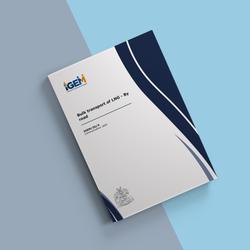IGEM/IG/4 - Bulk transportation of LNG - By road + amendments February 2024

This standard covers the design, construction, inspection, maintenance, operation and distribution of Liquified Natural Gas (LNG) by road and it’s ancillary loading and unloading equipment.
Minimum design and operational requirements are set out in Carriage of Dangerous Goods and Use of Transportable Pressure Equipment Regulations (ADR), which is implemented in the UK through the Carriage Of Dangerous Goods and Transportable Pressure Equipment Regulations (CDG). This Guidance contained within this standard details design features and safety systems which have been identified as being best practice within the UK and aligned with storage terminal requirements.
The scope of the standard includes:
- Legal considerations
- Safe handling and typical properties of LNG
- Design and Construction considerations
- Loading and Transportation
- Inspection and maintenance
Synopsis of IGEM/IG/4 with amendments February 2024
This Standard supersedes Edition 1 Communication 1854 published in 2023. It has been drafted by a Panel appointed by the Institution of Gas Engineers and Managers (IGEM’s) Technical Co-ordinating Committee, subsequently approved by the LNG Committee, and published by the authority of the Council of IGEM.
Introduction
1.1 This Industry Guidance is part of a series of Institution of Gas Engineers and Managers (IGEM) publications giving guidance on the operations and distribution of Liquified Natural Gas (LNG) by road.
1.2 This Guidance has been drafted by an Institution of Gas Engineers and Managers (IGEM) Panel, appointed by IGEM’s LNGC Committee, and has been approved by IGEM’s Technical Co-ordinating Committee on behalf of the Council of IGEM.
1.3 Terms such as “maximum operating pressure” (MOP), “maximum incidental pressure” (MIP) and “operating pressure” (OP) are used to reflect gas pressure terminology used in European standards. These terms will arise in all relevant IGEM Standards and, possibly, in other standards. Other terms have been introduced to assist in recognition of design information to be transferred between interested parties.
1.4 This Guidance makes use of the term “must”, “shall” and “should” when prescribing particular procedures.
- the term “must” identifies a requirement by law in Great Britain (GB) at the time of publication
- the term “shall” prescribes a procedure which, it is intended, will be complied with in full and without deviation
- the term “should” prescribes a procedure which, it is intended, will be complied with unless, after prior consideration, deviation is considered to be acceptable.
1.5 Such terms may have different meanings when used in legislation, or Health and Safety Executive (HSE) Approved Codes of Practice (ACoPs) or guidance, and reference needs to be made to such statutory legislation or official guidance for information on legal obligations.
1.6 New and improved practices may be adopted prior to this Guidance being updated. Amendments to this Guidance will be issued when necessary and their publication will be announced in the Journal of IGEM and elsewhere as appropriate.
1.7 Requests for interpretation of this Guidance in relation to matters within their scope, but not precisely covered by the current text, are to be either:
- addressed to Technical Services, IGEM, IGEM House, 26 & 28 High Street, Kegworth, Derbyshire, DE74 2DA; or
- emailed to [email protected].
These will be submitted to the relevant Committee for consideration and advice, but in the context that the final responsibility is that of the engineer concerned. If any advice is given by or on behalf of IGEM, this does not imply acceptance of liability for the consequences and does not relieve the responsible engineer of any of their obligations.
1.8 This Guidance was published in June 2023.
Scope
2.1 This Guidance document covers the design, construction, inspection, maintenance and operation of LNG transportable tankers and ancillary loading and unloading equipment.
2.2 Pressures quoted are gauge pressures unless otherwise stated.
2.3 Italicised text is informative and does not represent formal requirements.
2.4 Appendices are informative and do not represent formal requirements unless specifically referenced in the main sections via the prescriptive terms “must”, “shall” or “should”.
